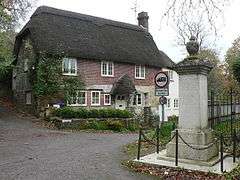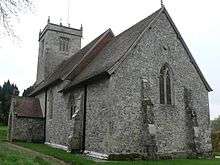Ebbesbourne Wake
Ebbesbourne Wake is a village and civil parish in Wiltshire, England, some 10 miles (16 km) south-west of Salisbury. It lies near the head of the valley of the small River Ebble. Included in it are the hamlets of Fifield Bavant and West End.
| Ebbesbourne Wake | |
|---|---|
 War memorial and Old Forge Cottage, Ebbesbourne Wake | |
 Ebbesbourne Wake Location within Wiltshire | |
| Population | 222 (in 2011)[1] |
| OS grid reference | ST992242 |
| Civil parish |
|
| Unitary authority | |
| Ceremonial county | |
| Region | |
| Country | England |
| Sovereign state | United Kingdom |
| Post town | Salisbury |
| Postcode district | SP5 |
| Dialling code | 01722 |
| Police | Wiltshire |
| Fire | Dorset and Wiltshire |
| Ambulance | South Western |
| UK Parliament | |
History
It is not known when Ebbesbourne was first inhabited or what it was called but fragmentary records from Saxon times (circa 826 AD) indicate that the whole Chalke Valley area was thriving, and the village was called Eblesburna. It is surmised that the land adjacent to the bourne (river) was once owned by a man called Ebbel.[2] Note that the word bourne is derived from the Old English "brunna".[3]
Mention is made of Ebbesbourne in the extant will of a Dorset woman, Wynflæd, in Latin. It is the earliest woman's will ("a small, stained sheet of parchment") to survive in British history. In a detailed testament, she bequeaths to her daughter Æthelflœd an engraved bracelet, a brooch, several named household articles, including books, and "the farm at Ebbesbourne with the title deed as a perpetual inheritance... and the men and the livestock on the land there to her too." The will was placed on display at the British Library in late 2018 and early 2019.[4]
The Domesday Book of 1086 divided the Chalke Valley into eight manors: Chelke (Chalke - Bowerchalke and Broadchalke), Eblesborne (Ebbesbourne Wake), Fifehide (Fifield), Cumbe (Coombe Bissett), Humitone (Homington), Odestoche (Odstock), Stradford (Stratford Tony and Bishopstone) and Trow (circa Alvediston and Tollard Royal).[5]
Peter Meers, in his book Ebbesbourne Wake through the Ages, translates the village's Domesday entry as:
Robert holds Eblesborne from Robert. Aluard and Fitheus held it before 1066 as two manors. (TRE = tempore Regis Edwardii, the time of Edward the Confessor, 1042-1066) Taxed for 14 hides.
Land for ten ploughs. In lordship ten hides, there six ploughs. Four slaves (serfs). Eighteen villeins (villagers). Seven bordars (smallholders) with four ploughs. Fourteen acres of meadow, pasture fourteen furlongs long, 4 furlongs wide. Woodlands two leagues length and width. Value £12, now £14.[2]
Geoffrey de Wak became Lord of the manor in 1204; although his relationship to Hereward the Wake is unknown, the shield of Hereward's coat of arms can today be seen on the church tower. By 1249 the settlement was known as Ebbelburn Wak and by 1785 as Ebesborne Wake.[6]
In the 12th century the area was known primarily as the Stowford Hundred, then subsequently as the Chalke Hundred. This included the parishes of Berwick St John, Ebbesbourne Wake, Fifield Bavant, Semley, Tollard Royal and 'Chalke'.[6]
Although the name Ebbesbourne Wake grew up over time, the spelling has varied. The Ordnance Survey of 1889 and 1927 used "Ebbesborne Wake", while the 1963 and 1974 maps retained "Ebbesborne" for the parish, but named the village Ebbesbourne Wake. Historian Peter Meers notes in Ebbesbourne Wake through the Ages that both the 1926 and 1965 editions of Fowler's A Dictionary of Modern English Usage describe the spelling of 'bourne/borne' as inconsistent.[7]
Manor Farmhouse is from the 17th century, with rebuilding and additions in the 18th and 19th.[8] A National School was opened in or before 1846; a schoolroom was built in 1854 and a teacher's house in 1870. The school closed in 1985 owing to low pupil numbers.[9]
The civil parish of Fifield Bavant was merged into Ebbesbourne Wake parish in 1894.[9]
Parish church

There has been a church at Ebbesbourne Wake since the 13th century.[9] The present church is largely 14th century, with 13th-century window details and a 12-century font.[10]
The tower has five bells, of which four are from the 17th century.[11] The church was designated as Grade II* listed in 1960.[10]
From 1859 the vicar of Ebbesbourne was also rector of Fifield Bavant, but not until 1923 were the two parishes united.[12] In 1970 the benefice was united with Alvediston[13] Today the parish is part of the Chalke Valley group.[14]
Chapel
An independent meeting house was established in 1782 at a cottage called Buntings.[15][16] In about 1791, the congregation moved to a former coach house belonging to the Earl of Pembroke, not far from the church. In 1857 a stone chapel was built on the same site.[17]
Local government
The civil parish has an elected parish council. It falls within the Wiltshire Council unitary authority, which is responsible for all significant local government functions.
Amenities
The village has a village hall and a public house, the Horseshoe Inn.
References
- Meers, Peter (2006). Ebbesbourne Wake through the Ages (PDF). Dial Cottage Press. Retrieved 19 August 2016.
- "Wiltshire Community History - Census". Wiltshire Council. Retrieved 21 January 2015.
- Meers 2006, p. 3.
- Michael Wood: "Wynflæd's Will". History Today, November 2018, pp. 78–83.
- Meers 2006, p. 5.
- Meers 2006, pp. 3-4.
- Meers 2006, p. 4.
- Historic England. "Manor Farmhouse (1250082)". National Heritage List for England. Retrieved 19 August 2016.
- Freeman, Jane; Stevenson, Janet H (1987). Crowley, D. A. (ed.). "Victoria County History: Wiltshire: Vol. 13, pp. 52–60 – Ebbesborne Wake". British History Online. University of London. Retrieved 19 August 2016.
- Historic England. "Church of St John the Baptist (1318690)". National Heritage List for England. Retrieved 18 August 2016.
- "Ebbesbourne Wake, St John". Dove's Guide for Church Bell Ringers. Retrieved 18 August 2016.
- "No. 32870". The London Gazette. 12 October 1923. pp. 6837–6839.
- "No. 45057". The London Gazette. 10 March 1970. p. 2856.
- "Ebbesbourne Wake – St John the Baptist". Chalke Valley Church. Archived from the original on 16 September 2016. Retrieved 18 August 2016.
- Meers 2006, p. 149.
- Historic England. "Buntings (1318691)". National Heritage List for England. Retrieved 18 August 2016.
- Meers 2006, p. 151.
External links
![]()
- "Ebbesbourne Wake". Wiltshire Community History. Wiltshire Council. Retrieved 16 October 2015.